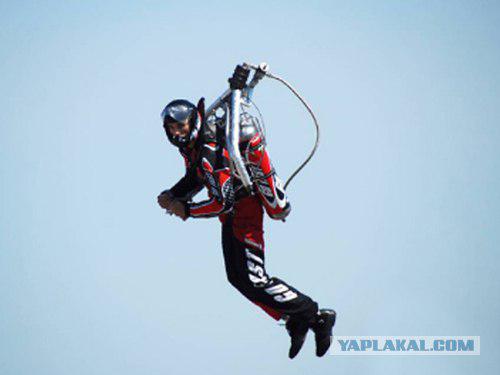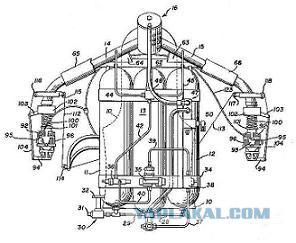717
Jet-pack - Myth or Reality?
In computer 3D-shooter jetpack (jetpack) can be worn on itself, like a hundredweight of other junk, and easy to use at any time - if you keep going, you only have additional degrees of freedom.
Consider the history of the development and emergence of a unique aircraft.

Yes, and you can shoot on the fly. The shooting during our hero must manage dzhetpakom? Yes, even, sorry, uh ... willpower, here. The game is a game. These jetpack while until recently could fly nearly a minute, and their controls had to hold on with both hands, so as not to fly at full speed a face into the asphalt and not be pinned on top of itself dzhetpakom. And yet it was necessary to have trained legs and spine. Because while you're in the air jetpack it brings you, but you should land - and he leans all his weight on your back. What you can use it nedoletayuschee misunderstanding? Ash stump - to show business. Still it is possible to organize the race. Although, of course, competition, lasting about a minute - is not particularly spectacular event. In general, the new jetpack - flying backpack New Zealand inventor Glenn Martin - a big step forward in the evolution of the individual aerial vehicles. Let's start with the fact that thanks to vodnoohlazhdaemomu engine capacity of 200 horsepower, this unit can carry a person for half an hour! Agree - this is a smart minute flight to and fro on a rocket, seasoned with concentrated hydrogen peroxide. For half an hour in a small town and you can work from home to get to. And the store for beer and did easily. This is the first. And secondly - a trifle, but nice - the new jetpack has a solid stand. That is, after the engine shutdown is not necessary to try to keep the whole edifice on itself. To create an advanced flying backpack Glen Martin spent 27 years. Naturally lifework. After a series of successful demonstrations, he is going to start selling the unit. One hundred thousand dollars per copy.
Jetpack (or jetpack; Eng. Jet pack, rocket pack, rocket belt, etc.) - A personal flying machine, worn on the back, allows a person to ascend into the air by the jet thrust. Thrust is created by the ejected vertically downwards engine jet.
There are two main types of jetpacks:
knapsack with a rocket engine (jetpack, rocket pack or rocket belt).
knapsack with turbojet engine (actually a jetpack, jet pack or jet belt);
Rocket packs quite simple in design, so they have spread. Classic jetpack designs Wendell Moore can be made in a private studio, though this requires good engineering training and a high level of skills of plumbing. The main drawback of rocket pack - short duration of the flight (30 seconds) and the high consumption of scarce fuel - hydrogen peroxide. These circumstances limit the scope of the rocket pack quite spectacular public demonstration flight. Flights to rocket backpack always capture the attention of viewers and have a great success. For example, a flight has been arranged during the grand opening of the Summer Olympic Games 1984 in Los Angeles, USA.
Schoolbags with turbojet engine running on traditional kerosene, have higher efficiency, greater height and length of the flight, but they are complex in design and are very expensive. To produce a pack in primitive conditions possible. Was created only one valid sample of the satchel, it passed flight tests in the 1960s and now is no longer flying.

History rocket backpack
Even during the Second World War, Germany made wide use of engines running on hydrogen peroxide: in torpedoes, submarines, aircraft and missiles. For example, a fighter-interceptor Me-163 had a liquid rocket engine, which supplied 80 per cent hydrogen peroxide and liquid catalyst (solution of potassium permanganate or a mixture of methanol, hydrazine hydrate, and water). In the combustion chamber, hydrogen peroxide decomposes to form large amounts of superheated steam-gas mixture, creating a powerful jet thrust. Serial plane had a speed of up to 960 km / h, could climb to an altitude of 12 000 meters in 3 minutes, with a duration of up to 8 minutes of flight. Hydrogen peroxide is also used in the V-2 rocket, but as an auxiliary fuel - it worked turbopumps, have submitted the fuel and oxidizer into the combustion chamber of the main rocket engine.
After the war, the German missile technology, along with the famous designer Werner von Braun came to the United States. One worked with Brown American engineers, Thomas Moore (Thomas Moore), came up with an individual aircraft, which he called "reactive vest" (eng. «Jet Vest»). "Reactive vest" working on hydrogen peroxide. In 1952, Moore was able to get a grant of 25 thousand dollars from the US Army to build and test their devices. "Jet Vest" was made on the test bench for a few seconds, he managed to lift the pilot off the ground.
However, the "vest" Moore had a very uncomfortable control system. On the breast of the pilot placed a box, from which cables go to the control rod and two control nozzles backpack. Right and left box had handwheels: handwheel operated thrust right and on the left two coaxial hand wheel operated steering left and right nozzles. Each nozzle may deviate forward or backward. If you needed to turn towards the pilot rotated the one handwheel, rejecting one nozzle. In order to fly forward or backward, the pilot rotated the two handwheel simultaneously. So it looks in theory. "Reactive vest" Thomas Moore was not able to make independent flight, the Army stopped funding, and work has been curtailed.
In 1958, Harry Alexander Burdett and Bohr, the company's engineers "Thiokol» («Thiokol Corp.»), created a "belt hopping» («Jump Belt»), to which they gave the name "Grasshopper" (eng. Project Grasshopper). Power was provided by high-pressure compressed nitrogen. On the "belt" were attached two small nozzles directed vertically downward. Media "belt" could open the valve, releasing a balloon compressed nitrogen through the nozzle, while its bouncing up to a height of 7 meters. Leaning forward, could be created using a "jump belt" run at a speed of traction of 45-50 km / h. Then Burdett and Bohr tried and hydrogen peroxide. "Jump belt" was shown in a military action, but the funding has not been, and continue to test experiments deal did not go again.
However, the US military did not lose interest in portable aircraft. Motor Vehicle Studies US Army (US Army Transportation Research Command, TRECOM) assumed that personal jet devices can find the most diverse range of applications: for reconnaissance, forcing rivers, amphibious landings, climb the steep mountain slopes, overcoming minefields, tactical maneuvering and so hereinafter. The concept is called "small rocket lifting device» (Small Rocket Lift Device, SRLD).
Within this framework, management concluded in 1959 with the company "Aerojet» («Aerojet-General») contract for the research on the possibility of creating SRLD, suitable for military purposes. "Aerojet" came to the conclusion that the most appropriate option is with the engine on hydrogen peroxide. But soon the military learned that the engineer Wendell Moore of the company "Bell Aerosystems» («Bell Aerosystems») for several years conducting experiments to create a personal jet device. After reading his work, the military in August 1960, decided to transfer the order to develop SLRD company 'Bell'. Wendell Moore was appointed as the lead engineer of the project.
Jetpack «Bell Rocket Belt». US patent number 3243144, 1966
Wendell Moore (Wendell F. Moore) worked in the "Bell Aerosystems' a rocket engineer. He began working on the creation of more jetpack in 1953 (probably learned about the work of his namesake Thomas Moore). The experiments began in the mid-1950s ("Bell" conducted the study at their own expense). Creating engine is not difficult - the use of hydrogen peroxide was well worked out rocket troops. The challenge was to achieve stable and sustained flight, and this required to develop a reliable and convenient system of governance knapsack in the air.
... Was made experimental "assembly" (eng. «The rig»), using compressed nitrogen. It had a frame of steel pipes, which has been "suspended" test. The frame is pivotally installed two nozzles. Flexible hose to the nozzle was summed nitrogen pressure of 35 atmospheres (he is fed from the tank). Engineer-operator on the ground regulated nitrogen supply valve and test podplechnymi levers tilted nozzle back and forth trying to achieve stable hovering at a low altitude. Bottom safety rope was tied, in order to "build" a tester not flown too high.
The first tests showed that the man is very fragile flying object. Empirically it was determined the best location of the jet nozzles of the center of gravity, their direction, their management in flight. The test "Flight" was itself Wendell Moore and other members of his group. The first flights were more like short and sharp jumps, but further experiments were very successful - in 1958 on the "assembly" was able to achieve a stable flight at a height of up to 5 meters in three minutes. It is these successes impressed the military, determined the choice in favor of "Bell". The contract with the Office of Transport Research provides manufacturing, testing and demonstration of Flight ready SRLD.
For knapsack manufactured rocket engine with a thrust of 280 pounds (127 kgs). The total weight of the knapsack with the fuel was 57 kg. Satchel had a solid fiberglass corset made in the form of the body. By tightly fastened corset cylinders with fuel and nitrogen. The propulsion system is pivotally fastened and managed podplechnymi levers. Engine thrust varied regulator connected to the handle on the right arm. The handle on the left arm drove divergent nozzle (jetavators). The pilot was fastened to the corset belts.
Tests created satchel began in late 1960. The flights were carried out in a large hangar "on a leash" (t. E. With safety rope). The first twenty "tethered" ups made personally Wendell Moore, testing the operation of control systems, detecting defects and improving design pack. 17 February 1961, due to tether the accident occurred. During the flight pack went sharply to the side, I choose the length of the cable, and the burst. The pilot with the knapsack down on the left side from a height of about two and a half meters. As a result, Moore had a broken kneecap, and fly it no longer had. After this function test pilot took over Moore's colleague, engineer Harold Graham (Harold Graham). March 1 flights were resumed. Graham performed 36 more "tethered" test ups, learning management satchel in the air. Finally, a satchel and the pilot were ready for this flight.
20 April 1961 (a week after Gagarin's flight) in a vacant lot near the airport of the town of Niagara Falls was committed first ever free flight on the rocket backpack (open area without a leash). Pilot Harold Graham rose to a height of about 4 feet (1 m 2), and gently flew forward at a speed of about 10 km / h. He flew in a straight line 108 feet (less than 35 meters) and landed. The entire flight lasted 13 seconds. Jetpack ceased to be a fiction.
In subsequent flights of Graham practiced management techniques knapsack and master more complex techniques of piloting. He learned to fly in a circle, and turn on a dime, flew across streams, cars, ten-hills, flying between the trees. Total April and May has been made 28 flights. Wendell Moore sought an absolutely reliable operation of the backpack and self-piloting of Graham, then to not drop a clanger to the public. During the tests had the following maximum values:
flight duration - 21 seconds;
flight range - 120 meters;
height - 10 meters;
speed - 55 km / h.
June 8th, 1961 backpack was first shown publicly - in front of several hundred officers at the military base of Fort Eustis (Fort Eustis). This was followed by other public displays, including the famous flying in the courtyard of the Pentagon in front of three thousand employees of the military department, which enthusiastically watched as Harold Graham flies over the passenger car.
October 11, 1961 (according to other sources - October 12) pack was demonstrated personally to President Kennedy during the demonstration maneuvers on the military base Fort Bragg (Fort Bragg). Graham took off from the amphibious LST, flew over the strip of water, landed a few meters in front of the president and saluted smartly Commander of the US Army. According to eyewitnesses, the President watched the flight gasped.
Harold Graham with the serving team toured many cities in the United States, traveled to Canada, Mexico, Argentina, Germany, France and other countries, each time with great success demonstrating the jetpack in action to the general public.
The army also was disappointed. The maximum duration of the flight rocket pack was 21 seconds, a range of 120 meters. This was accompanied by a team of pack attendants. During one flight dvadtsatisekundny spend up to 5 gallons (19 liters) of hydrogen peroxide deficiency. According to the military, «Bell Rocket Belt» was more spectacular toy than an effective vehicle. The costs of the army on a contract with the "Bell Aerosystems" amounted to $ 150 000, another 50 000 dollars spent itself, "Bell." From the continuation of the program SRLD military refused, the contract was completed. Design and Function rocket backpack
All existing rocket packs based on the design backpack «Bell Rocket Belt», developed in the years 1960-1969 Wendell Moore. Satchel Moore structurally consists of two main parts:
Hard fiberglass brace (8) is fixed on the body of the pilot belt system (10). The corset has a rear metal tubular frame on which the three-cylinder, two with a liquid hydrogen peroxide (6) and one with compressed nitrogen (7). When the pilot is on the ground, corset distributes the weight of the backpack on your back and waist of the pilot.
A rocket engine, is movably mounted on a ball joint (9) in the upper part of the corset. Rocket engine itself consists of a gas generator (1) and two strictly connected with him pipe (2), that end of the nozzle with controlled tips (3). The engine is rigidly connected to two arms that pass under the hands of the pilot. These levers of the pilot tilts the motor forward or backward, and sideways. On the right arm mounted rotary handle traction control (5) associated with rope control valve (4) the fuel supply to the engine. On the left arm mounted steering handle, which is flexible rods connected to the control jet nozzle tips.
The action of the rocket engine based on the decomposition of hydrogen peroxide. It uses hydrogen peroxide concentration of 90 percent (a colorless liquid density of 1, 35 g / cm³). Hydrogen peroxide in its pure form is relatively stable, but in contact with the catalyst (e.g., silver) is rapidly decomposed into water and oxygen, less than 1/10 millisecond increasing in volume 5000 times.
2H2O2 → 2H2O + O2
The reaction proceeds exothermically, ie release of large amounts of heat (about 2500 kJ / kg). Thereby forming a gas-vapor mixture at a temperature of 740 ° C.
Principle of operation:
The pilot turns the handle control engine thrust, and control valve opens. Compressed nitrogen displaces the liquid hydrogen peroxide is fed through the pipes into the gasifier. There it comes into contact with the catalyst (thin silver plates coated with samarium nitrate) and decomposed. The resulting gas-vapor mixture of high pressure and temperature enters the two pipes coming out of the gas generator (pipes covered with a layer of heat insulation to reduce heat loss). Then the hot gases enter the jet nozzle (Laval nozzle) where the first accelerated and then expanding, acquiring and creating a supersonic speed jet thrust. The whole structure is simple and reliable, the rocket engine does not have any moving parts.
Satchel has two arms, rigidly connected with the propulsion system. Clicking on these levers, the pilot makes the nozzle to lean back and backpack flying forward. Accordingly, the lifting arm makes move back pack. You can tilt the propulsion system and the part (thanks to a ball joint) to fly sideways.
Source:
Consider the history of the development and emergence of a unique aircraft.

Yes, and you can shoot on the fly. The shooting during our hero must manage dzhetpakom? Yes, even, sorry, uh ... willpower, here. The game is a game. These jetpack while until recently could fly nearly a minute, and their controls had to hold on with both hands, so as not to fly at full speed a face into the asphalt and not be pinned on top of itself dzhetpakom. And yet it was necessary to have trained legs and spine. Because while you're in the air jetpack it brings you, but you should land - and he leans all his weight on your back. What you can use it nedoletayuschee misunderstanding? Ash stump - to show business. Still it is possible to organize the race. Although, of course, competition, lasting about a minute - is not particularly spectacular event. In general, the new jetpack - flying backpack New Zealand inventor Glenn Martin - a big step forward in the evolution of the individual aerial vehicles. Let's start with the fact that thanks to vodnoohlazhdaemomu engine capacity of 200 horsepower, this unit can carry a person for half an hour! Agree - this is a smart minute flight to and fro on a rocket, seasoned with concentrated hydrogen peroxide. For half an hour in a small town and you can work from home to get to. And the store for beer and did easily. This is the first. And secondly - a trifle, but nice - the new jetpack has a solid stand. That is, after the engine shutdown is not necessary to try to keep the whole edifice on itself. To create an advanced flying backpack Glen Martin spent 27 years. Naturally lifework. After a series of successful demonstrations, he is going to start selling the unit. One hundred thousand dollars per copy.
Jetpack (or jetpack; Eng. Jet pack, rocket pack, rocket belt, etc.) - A personal flying machine, worn on the back, allows a person to ascend into the air by the jet thrust. Thrust is created by the ejected vertically downwards engine jet.
There are two main types of jetpacks:
knapsack with a rocket engine (jetpack, rocket pack or rocket belt).
knapsack with turbojet engine (actually a jetpack, jet pack or jet belt);
Rocket packs quite simple in design, so they have spread. Classic jetpack designs Wendell Moore can be made in a private studio, though this requires good engineering training and a high level of skills of plumbing. The main drawback of rocket pack - short duration of the flight (30 seconds) and the high consumption of scarce fuel - hydrogen peroxide. These circumstances limit the scope of the rocket pack quite spectacular public demonstration flight. Flights to rocket backpack always capture the attention of viewers and have a great success. For example, a flight has been arranged during the grand opening of the Summer Olympic Games 1984 in Los Angeles, USA.
Schoolbags with turbojet engine running on traditional kerosene, have higher efficiency, greater height and length of the flight, but they are complex in design and are very expensive. To produce a pack in primitive conditions possible. Was created only one valid sample of the satchel, it passed flight tests in the 1960s and now is no longer flying.

History rocket backpack
Even during the Second World War, Germany made wide use of engines running on hydrogen peroxide: in torpedoes, submarines, aircraft and missiles. For example, a fighter-interceptor Me-163 had a liquid rocket engine, which supplied 80 per cent hydrogen peroxide and liquid catalyst (solution of potassium permanganate or a mixture of methanol, hydrazine hydrate, and water). In the combustion chamber, hydrogen peroxide decomposes to form large amounts of superheated steam-gas mixture, creating a powerful jet thrust. Serial plane had a speed of up to 960 km / h, could climb to an altitude of 12 000 meters in 3 minutes, with a duration of up to 8 minutes of flight. Hydrogen peroxide is also used in the V-2 rocket, but as an auxiliary fuel - it worked turbopumps, have submitted the fuel and oxidizer into the combustion chamber of the main rocket engine.
After the war, the German missile technology, along with the famous designer Werner von Braun came to the United States. One worked with Brown American engineers, Thomas Moore (Thomas Moore), came up with an individual aircraft, which he called "reactive vest" (eng. «Jet Vest»). "Reactive vest" working on hydrogen peroxide. In 1952, Moore was able to get a grant of 25 thousand dollars from the US Army to build and test their devices. "Jet Vest" was made on the test bench for a few seconds, he managed to lift the pilot off the ground.
However, the "vest" Moore had a very uncomfortable control system. On the breast of the pilot placed a box, from which cables go to the control rod and two control nozzles backpack. Right and left box had handwheels: handwheel operated thrust right and on the left two coaxial hand wheel operated steering left and right nozzles. Each nozzle may deviate forward or backward. If you needed to turn towards the pilot rotated the one handwheel, rejecting one nozzle. In order to fly forward or backward, the pilot rotated the two handwheel simultaneously. So it looks in theory. "Reactive vest" Thomas Moore was not able to make independent flight, the Army stopped funding, and work has been curtailed.
In 1958, Harry Alexander Burdett and Bohr, the company's engineers "Thiokol» («Thiokol Corp.»), created a "belt hopping» («Jump Belt»), to which they gave the name "Grasshopper" (eng. Project Grasshopper). Power was provided by high-pressure compressed nitrogen. On the "belt" were attached two small nozzles directed vertically downward. Media "belt" could open the valve, releasing a balloon compressed nitrogen through the nozzle, while its bouncing up to a height of 7 meters. Leaning forward, could be created using a "jump belt" run at a speed of traction of 45-50 km / h. Then Burdett and Bohr tried and hydrogen peroxide. "Jump belt" was shown in a military action, but the funding has not been, and continue to test experiments deal did not go again.
However, the US military did not lose interest in portable aircraft. Motor Vehicle Studies US Army (US Army Transportation Research Command, TRECOM) assumed that personal jet devices can find the most diverse range of applications: for reconnaissance, forcing rivers, amphibious landings, climb the steep mountain slopes, overcoming minefields, tactical maneuvering and so hereinafter. The concept is called "small rocket lifting device» (Small Rocket Lift Device, SRLD).
Within this framework, management concluded in 1959 with the company "Aerojet» («Aerojet-General») contract for the research on the possibility of creating SRLD, suitable for military purposes. "Aerojet" came to the conclusion that the most appropriate option is with the engine on hydrogen peroxide. But soon the military learned that the engineer Wendell Moore of the company "Bell Aerosystems» («Bell Aerosystems») for several years conducting experiments to create a personal jet device. After reading his work, the military in August 1960, decided to transfer the order to develop SLRD company 'Bell'. Wendell Moore was appointed as the lead engineer of the project.
Jetpack «Bell Rocket Belt». US patent number 3243144, 1966
Wendell Moore (Wendell F. Moore) worked in the "Bell Aerosystems' a rocket engineer. He began working on the creation of more jetpack in 1953 (probably learned about the work of his namesake Thomas Moore). The experiments began in the mid-1950s ("Bell" conducted the study at their own expense). Creating engine is not difficult - the use of hydrogen peroxide was well worked out rocket troops. The challenge was to achieve stable and sustained flight, and this required to develop a reliable and convenient system of governance knapsack in the air.
... Was made experimental "assembly" (eng. «The rig»), using compressed nitrogen. It had a frame of steel pipes, which has been "suspended" test. The frame is pivotally installed two nozzles. Flexible hose to the nozzle was summed nitrogen pressure of 35 atmospheres (he is fed from the tank). Engineer-operator on the ground regulated nitrogen supply valve and test podplechnymi levers tilted nozzle back and forth trying to achieve stable hovering at a low altitude. Bottom safety rope was tied, in order to "build" a tester not flown too high.
The first tests showed that the man is very fragile flying object. Empirically it was determined the best location of the jet nozzles of the center of gravity, their direction, their management in flight. The test "Flight" was itself Wendell Moore and other members of his group. The first flights were more like short and sharp jumps, but further experiments were very successful - in 1958 on the "assembly" was able to achieve a stable flight at a height of up to 5 meters in three minutes. It is these successes impressed the military, determined the choice in favor of "Bell". The contract with the Office of Transport Research provides manufacturing, testing and demonstration of Flight ready SRLD.
For knapsack manufactured rocket engine with a thrust of 280 pounds (127 kgs). The total weight of the knapsack with the fuel was 57 kg. Satchel had a solid fiberglass corset made in the form of the body. By tightly fastened corset cylinders with fuel and nitrogen. The propulsion system is pivotally fastened and managed podplechnymi levers. Engine thrust varied regulator connected to the handle on the right arm. The handle on the left arm drove divergent nozzle (jetavators). The pilot was fastened to the corset belts.
Tests created satchel began in late 1960. The flights were carried out in a large hangar "on a leash" (t. E. With safety rope). The first twenty "tethered" ups made personally Wendell Moore, testing the operation of control systems, detecting defects and improving design pack. 17 February 1961, due to tether the accident occurred. During the flight pack went sharply to the side, I choose the length of the cable, and the burst. The pilot with the knapsack down on the left side from a height of about two and a half meters. As a result, Moore had a broken kneecap, and fly it no longer had. After this function test pilot took over Moore's colleague, engineer Harold Graham (Harold Graham). March 1 flights were resumed. Graham performed 36 more "tethered" test ups, learning management satchel in the air. Finally, a satchel and the pilot were ready for this flight.
20 April 1961 (a week after Gagarin's flight) in a vacant lot near the airport of the town of Niagara Falls was committed first ever free flight on the rocket backpack (open area without a leash). Pilot Harold Graham rose to a height of about 4 feet (1 m 2), and gently flew forward at a speed of about 10 km / h. He flew in a straight line 108 feet (less than 35 meters) and landed. The entire flight lasted 13 seconds. Jetpack ceased to be a fiction.
In subsequent flights of Graham practiced management techniques knapsack and master more complex techniques of piloting. He learned to fly in a circle, and turn on a dime, flew across streams, cars, ten-hills, flying between the trees. Total April and May has been made 28 flights. Wendell Moore sought an absolutely reliable operation of the backpack and self-piloting of Graham, then to not drop a clanger to the public. During the tests had the following maximum values:
flight duration - 21 seconds;
flight range - 120 meters;
height - 10 meters;
speed - 55 km / h.
June 8th, 1961 backpack was first shown publicly - in front of several hundred officers at the military base of Fort Eustis (Fort Eustis). This was followed by other public displays, including the famous flying in the courtyard of the Pentagon in front of three thousand employees of the military department, which enthusiastically watched as Harold Graham flies over the passenger car.
October 11, 1961 (according to other sources - October 12) pack was demonstrated personally to President Kennedy during the demonstration maneuvers on the military base Fort Bragg (Fort Bragg). Graham took off from the amphibious LST, flew over the strip of water, landed a few meters in front of the president and saluted smartly Commander of the US Army. According to eyewitnesses, the President watched the flight gasped.
Harold Graham with the serving team toured many cities in the United States, traveled to Canada, Mexico, Argentina, Germany, France and other countries, each time with great success demonstrating the jetpack in action to the general public.
The army also was disappointed. The maximum duration of the flight rocket pack was 21 seconds, a range of 120 meters. This was accompanied by a team of pack attendants. During one flight dvadtsatisekundny spend up to 5 gallons (19 liters) of hydrogen peroxide deficiency. According to the military, «Bell Rocket Belt» was more spectacular toy than an effective vehicle. The costs of the army on a contract with the "Bell Aerosystems" amounted to $ 150 000, another 50 000 dollars spent itself, "Bell." From the continuation of the program SRLD military refused, the contract was completed. Design and Function rocket backpack
All existing rocket packs based on the design backpack «Bell Rocket Belt», developed in the years 1960-1969 Wendell Moore. Satchel Moore structurally consists of two main parts:
Hard fiberglass brace (8) is fixed on the body of the pilot belt system (10). The corset has a rear metal tubular frame on which the three-cylinder, two with a liquid hydrogen peroxide (6) and one with compressed nitrogen (7). When the pilot is on the ground, corset distributes the weight of the backpack on your back and waist of the pilot.
A rocket engine, is movably mounted on a ball joint (9) in the upper part of the corset. Rocket engine itself consists of a gas generator (1) and two strictly connected with him pipe (2), that end of the nozzle with controlled tips (3). The engine is rigidly connected to two arms that pass under the hands of the pilot. These levers of the pilot tilts the motor forward or backward, and sideways. On the right arm mounted rotary handle traction control (5) associated with rope control valve (4) the fuel supply to the engine. On the left arm mounted steering handle, which is flexible rods connected to the control jet nozzle tips.
The action of the rocket engine based on the decomposition of hydrogen peroxide. It uses hydrogen peroxide concentration of 90 percent (a colorless liquid density of 1, 35 g / cm³). Hydrogen peroxide in its pure form is relatively stable, but in contact with the catalyst (e.g., silver) is rapidly decomposed into water and oxygen, less than 1/10 millisecond increasing in volume 5000 times.
2H2O2 → 2H2O + O2
The reaction proceeds exothermically, ie release of large amounts of heat (about 2500 kJ / kg). Thereby forming a gas-vapor mixture at a temperature of 740 ° C.
Principle of operation:
The pilot turns the handle control engine thrust, and control valve opens. Compressed nitrogen displaces the liquid hydrogen peroxide is fed through the pipes into the gasifier. There it comes into contact with the catalyst (thin silver plates coated with samarium nitrate) and decomposed. The resulting gas-vapor mixture of high pressure and temperature enters the two pipes coming out of the gas generator (pipes covered with a layer of heat insulation to reduce heat loss). Then the hot gases enter the jet nozzle (Laval nozzle) where the first accelerated and then expanding, acquiring and creating a supersonic speed jet thrust. The whole structure is simple and reliable, the rocket engine does not have any moving parts.
Satchel has two arms, rigidly connected with the propulsion system. Clicking on these levers, the pilot makes the nozzle to lean back and backpack flying forward. Accordingly, the lifting arm makes move back pack. You can tilt the propulsion system and the part (thanks to a ball joint) to fly sideways.
Source:























